Westonbirt Arboretum
The National Arboretum
nr Tetbury, Gloucestershire
|

Featured Location Guide |
|
Westonbirt in Gloucestershire, became The National Arboreta in 2001 along
with Bedgebury Pinetum in
Kent.
It has an historic collection of over 3000 different trees and shrub species
and over 15,500 individual specimens, many of which are rare or endangered
in their native lands, covering 600 acres. It is possibly the most well
known arboretum in the UK.
What to see
There are two main areas to Westonbirt, Silk Wood and The Old Arboretum, but
there is also The Downs, between the car park and Silk Wood which is a
limestone grassland. It is grazed most of the year by cows and in spring is
where you will find a display of green-winged and bee orchids.
Silk
Wood is 70 hectares of semi-natural woodland. As well as the trees there is
also to be found flowers, butterflies and fungi. The fungi is regularly
monitored and the last count revealed over 1100 species - some of which are
very rare.
 
|

|
Autumn Highlights
 include: the maples in Old Acer Glade which date back
to 1875 and are believed to be among the earliest imported from Japan.
Persian Ironwood, maples and spindles create an amphitheatre. Also look out
on Main Drive for the rich buttery-yellow leaves of the big-bud hickory, and
out on the downs the magnificent bronze beeches. A kaleidoscope of leaves,
are intermingled with fruits and seeds of all colours - from yellow, red and
orange to black, pure white and even blue. The spindle trees on
Circular Drive
- with their orange seeds dangling from waxy pink capsules - are especially
eye-catching.
include: the maples in Old Acer Glade which date back
to 1875 and are believed to be among the earliest imported from Japan.
Persian Ironwood, maples and spindles create an amphitheatre. Also look out
on Main Drive for the rich buttery-yellow leaves of the big-bud hickory, and
out on the downs the magnificent bronze beeches. A kaleidoscope of leaves,
are intermingled with fruits and seeds of all colours - from yellow, red and
orange to black, pure white and even blue. The spindle trees on
Circular Drive
- with their orange seeds dangling from waxy pink capsules - are especially
eye-catching.
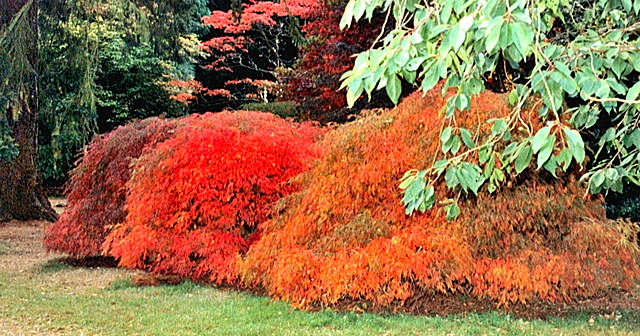

Winter Highlights
 include: the witch hazels in Savill Glade whose
spidery yellow flowers reliably bloom in mid-winter regardless of the
weather. The yellow flowering tree, the cornelian cherry, can be seen at
Skilling Gate. If you want colour and scent then seek out the Christmas box
around Circular and Main Drives, whose spiky white flowers give off a
delightful scent. In January and February the hazel trees in Silkwood are
festooned with their dangling lemon catkins, look closely and you should see
the purple spikes of the female flowers.
include: the witch hazels in Savill Glade whose
spidery yellow flowers reliably bloom in mid-winter regardless of the
weather. The yellow flowering tree, the cornelian cherry, can be seen at
Skilling Gate. If you want colour and scent then seek out the Christmas box
around Circular and Main Drives, whose spiky white flowers give off a
delightful scent. In January and February the hazel trees in Silkwood are
festooned with their dangling lemon catkins, look closely and you should see
the purple spikes of the female flowers.
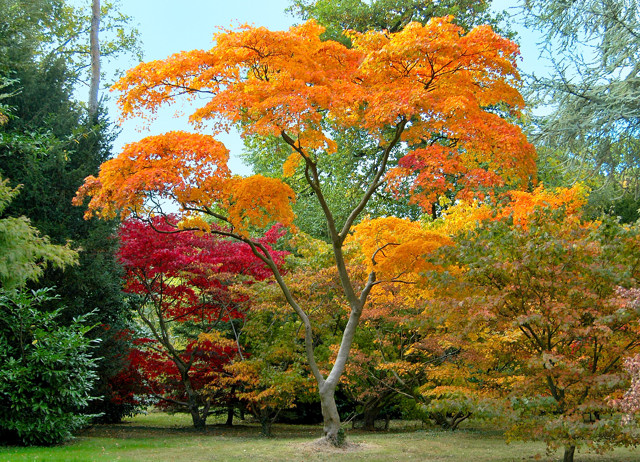

Spring Highlights
 include: the opening of blossom with colours from magnolias, camellias,
rhododendrons (usually at their best during March, although start to flower
at end of February) in the Old Arboretum. In April
Rhododendron
williamsianum is in full bloom with it's heart shaped leaves and bell shaped
pink flowers can be seen on the edge of Main Drive near Dukes Cut Gate.
There is also a spectacular spread of wildflowers carpeting the woodland
floor including celandines, wood anemones, with primroses,
bluebells,
include: the opening of blossom with colours from magnolias, camellias,
rhododendrons (usually at their best during March, although start to flower
at end of February) in the Old Arboretum. In April
Rhododendron
williamsianum is in full bloom with it's heart shaped leaves and bell shaped
pink flowers can be seen on the edge of Main Drive near Dukes Cut Gate.
There is also a spectacular spread of wildflowers carpeting the woodland
floor including celandines, wood anemones, with primroses,
bluebells,
 wood violets and more carpet Silk Wood.
wood violets and more carpet Silk Wood.
Summer Highlights
 include: the Hawthorn in May and June, or the
incredible white handkerchief tree on
Main Drive.
During the main summer months of July and August the North American tulip
tree in Jackson Avenue will be out in flower.
include: the Hawthorn in May and June, or the
incredible white handkerchief tree on
Main Drive.
During the main summer months of July and August the North American tulip
tree in Jackson Avenue will be out in flower.
|
A little bit of history
The arboretum was
established in 1829 by Robert Stayner Holford who inherited the estate 10
years later. He took on transforming the estate and not only rebuilt Westonbirt House with formal pleasure gardens, now a girls' boarding school,
and on the other side of the road, but also the arboretum. Many
plant-hunters of the time were bringing in new and exotic species from
around the British Empire and Robert was able to get some of them for his
collection. By 1855 much of the Old Arboretum had been laid out including
Main Drive and Specimen Avenue.
|
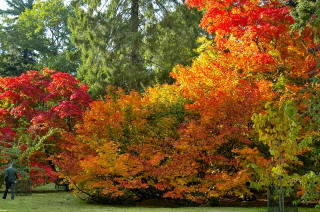

 Click on images to see
larger version
Click on images to see
larger version |
It was later extended by
his son Sir George Holford from the 1880's. He extended the arboretum across
the valley into Silk Wood, clearing natural woodland and creating more
drives with wide verges and bays of ornamental trees. He was also
responsible for the planting of the many rhododendrons and maples and glades
such as Acer Glade, Savill Glade and Victory Glade and sometime around 1905,
28 Tulip trees were planted in Jackson Avenue. From 1910-1912 George
contributed to a Chinese expedition and was provided with seed from it. He
also made donations to Kew including over 200 orchids which he had raised at
Westonbirt.
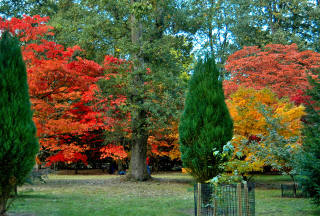   |
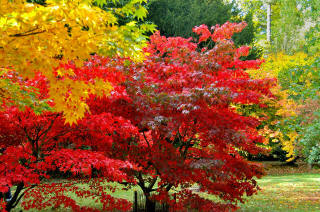   |
|
Click on smaller images
to see larger versions |
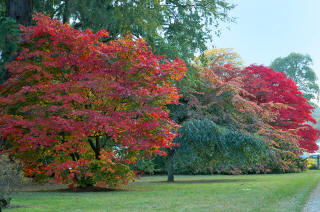   |
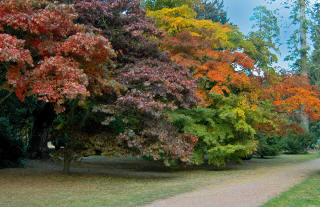   |
After the death of George
in 1926 ownership passed to his nephew the fourth Earl of Morley and in 1927
the estate was split up, with the mansion being sold to Rev. P Warrington
for it to become a girls school. When the fourth Earl died in 1951 it passed
to his brother, but lack of maintenance and WWII left the arboretum in a
poor state and in 1956 it was handed over to the Forestry Commission. They
spent the next seven years cataloguing the specimens and mapping the site as
well as bringing it back into a state which could be used by the public.
This was achieved in 1961 when the first members of the public were
admitted. Various new glades were added and developed over the next 20+
years and in 1982 they developed the Japanese Maple Cultivar Collection in
Silk Wood.
Today it is now a
resource for conservation, recreation and education and available for the
public to use and admire, with over 350,000 of us visiting annually.
|
Discovering the trees
Nearly all specimens have a black label which gives it's name and place of
origin. Within the Great Oak Hall (open 10am-4pm every day except Christmas
Day) there is a WOW board which shows the plants which are at their best at
your time of visit - this is updated every two weeks. But they also have a
free guided walk every weekend at 2pm from Easter to end of October. This
lasts for about 2 hours and gives an introduction to what is available to
see. They also have a number of themed walks looking a particular topics
throughout the year. A free map is available on arrival at the arboretum
from the Great Oak Hall
Other Activities
Various events take place throughout the year such as the Festival of The
Tree which takes place in August. The
Westonbirt Arboretum - Enchanted Christmas
 runs weekends, Fri-Sun from
November-December when it is open from
5pm, and the forest is lit up and you can take a
walk through the forest and see Father Christmas plus lots of other festive
activities such as carols from local choirs and bands, roast chestnuts and
mulled wine. Around 30,000 people attend this each year.
runs weekends, Fri-Sun from
November-December when it is open from
5pm, and the forest is lit up and you can take a
walk through the forest and see Father Christmas plus lots of other festive
activities such as carols from local choirs and bands, roast chestnuts and
mulled wine. Around 30,000 people attend this each year.
|
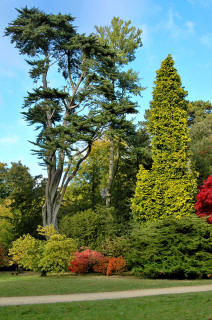   Click on
image to see Click on
image to see
larger version
|
The Friends of
Westonbirt Arboretum
Is a
registered charity set up in 1985 to help support the Forestry Commissions
work. It has a membership of over 21,000, growing annually, and provides
support in the form of finance and volunteers. Around 250 volunteers help
out in a variety of roles including maintenance of the tree collection,
propagation assistances and as guides. If you want to find out more about
them then they have their
own website.

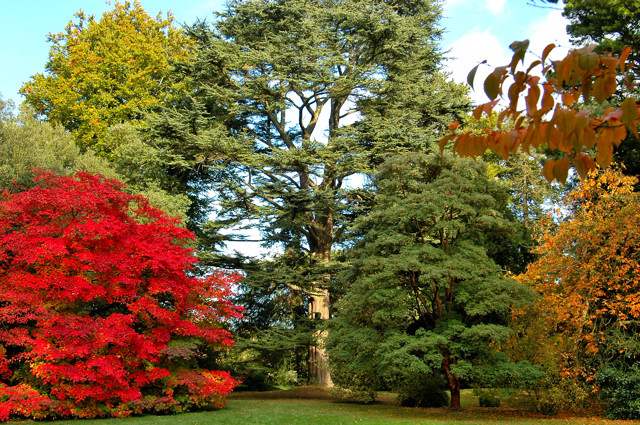

.
Planning Grid
|
Location: |
Westonbirt Arboretum, nr Tetbury,
Gloucestershire |
|
Grid Reference: |
ST851898 |
|
Getting there: |
On the A433 3 miles south of Tetbury. |
|
Access: |
Via a long drive off the A433 to the car park
and then on foot from here. |
|
Parking: |
Landscaped main car park past admissions
point, but also uses grass areas when busy. Disabled car park next to Maples
Restaurant. Car parking is free except during December when admission charge
is per car rather than per person. |
|
Facilities: |
Restaurant, cafe, shop, picnic area, toilets
next to Great Oak Hall in the Old arboretum, and at the Plant Centre and
Maples Restaurant. |
|
Things To Do,
See and Photograph: |
Trees and shrubs, fungi, wildlife |
|
What to take: |
wide angle lens, tripod, macro lens |
|
Nature highlights: |
Autumn, spectacular colours of deep reds from
Japanese Maples to yellows, russets etc as well as the colourful fruits and
berries on some of the trees, and fungi underfoot. Maybe birds. |
|
Address: |
Westonbirt 'The National Arboretum'
Nr Tetbury
Gloucestershire |
|
Postcode: |
GL8 8QS |
|
Telephone: |
01666 880220 |
|
Opening times: |
April-August 9am-8pm; September-March
9am-5pm
|
|
Charges: |
Normal Admission
Mar-Sept: Adults £8; Concessions £7; Child
(5-18) £3
Oct-Nov: Adults £9; Concessions £8; Child
(5-18) £4
Dec-Feb: Adult £5; Concessions £4, Child
(5-18) £2
Annual Event Admission
Treefest: Adults £12; Concessions £10; Child
(5-18) FREE
Enchanted Christmas: Adult £9; Concessions £8;
Child (5-18) £5
Under 5's FREE at all times.
Concessions include senior citizens, students
and disabled adults.
Friends of Westonbirt get FREE normal
admission and FREE entry to Treefest, with half price at Enchanted
Christmas.
There are other special rates for groups see
website
 for details. for details. |
|
Photo Restrictions: |
Encouraged for personal or educational use and
no charge for non-commercial photography or filming. Permits are required
for location photography or filming. |
|
Other Restrictions: |
Cycling is NOT allowed in the arboretum. |
|
Special Needs Access: |
17 miles of hard paths throughout arboretum,
other trails off these paths are accessible depending on weather conditions. |
|
Special Needs Facilities: |
2 disabled toilets. Special parking bays near
the facilities. Electric scooters, 2 seater buggies and manual wheelchairs
available. |
|
Children Facilities: |
Baby changing facilities in the toilets next
to the Great Oak Hall in the old arboretum. |
|
Dogs Allowed: |
Dogs can run freely in Silk Wood except when
livestock in the area, but use the litter bins for any mess they make.
Dog FREE Zones include the Old Arboretum,
Maples Restaurant, the Great Oak Hall, the forest shop and toilets. |
|

|
Please let us know any other information that we
can add to the Further information and Planning Grids or page and any errors that you discover. Before making a long trip to any location it is always
wise to double check the current information, websites like magazines may be
correct at the time the information is written, but things change and it is of
course impossible to double check all entries on a regular basis. If you have
any good photographs that you feel would improve the illustration of this page
then please let us have copies. In referring to this page it is helpful if you
quote both the Page Ref and section/topic references from the Grid below. To print the
planning grid select it then right click and print the selected area.
Please submit information on locations you discover so
that this system continues to grow.
|